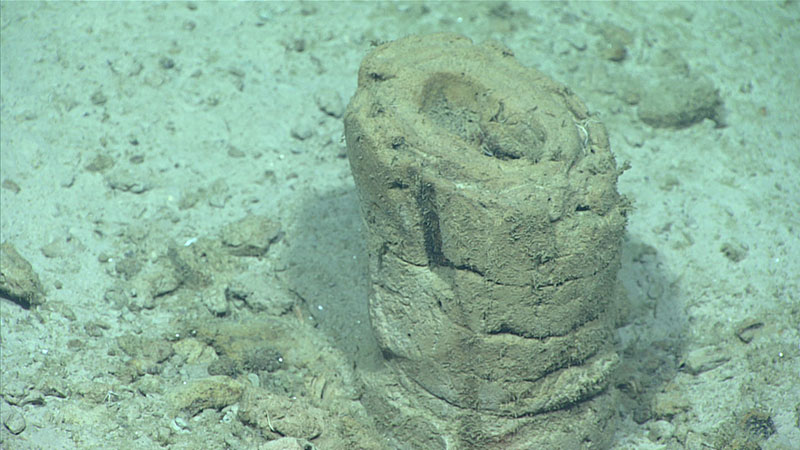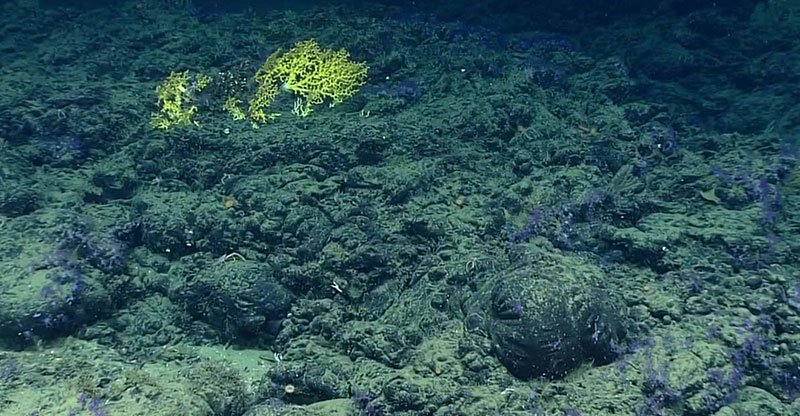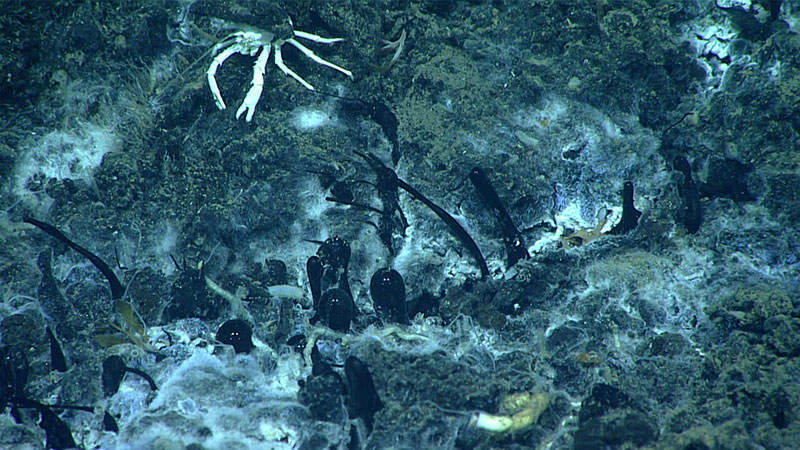
By Dr. Carolyn Ruppel, Research Geophysicist, U.S. Geological Survey
Dr. Robert S. Carney, Prof. Emeritus, Dept. Oceanography & Coastal Sciences, Louisiana State University
December 17, 2017

Map showing the northern Gulf of Mexico, with the locations of Dive 09, which discovered an asphalt seep at the seafloor, and the 2014 “tar lily” dive, which found seafloor formations made of extruded asphalt. The Sigsbee Escarpment marks the southern edge of the salt sheet that underlies the northern Gulf of Mexico. Bathymetry north of the Sigsbee Escarpment from the Bureau of Ocean Energy Management’s dataset. Image courtesy of the U.S. Geological Survey. Download larger version (jpg, 4.5 MB).
During Dive 09 of the Okeanos Explorer Gulf of Mexico 2017 expedition, NOAA’s Deep Discoverer (D2) remotely operated vehicle (ROV) found an asphalt seep at ~1,150 meters (~3,775 feet) water depth in an area known as Henderson Ridge. This is not the first time that NOAA’s Office of Ocean Exploration and Research has discovered asphalt in locations where it was previously unknown in the northern Gulf of Mexico: In 2014, D2 found evidence of asphalt extrusions that had formed “tar lilies” on the seafloor ~170 kilometers (~105 statute miles) to the southwest of Henderson Ridge. Asphalt volcanism has also been described in the Green Canyon area of the northern Gulf of Mexico, at over 3,000 meters (~9,840 feet) water depth in the southern Gulf of Mexico (Campeche Knolls), on the Brazilian and Angolan margins, and offshore California.

Columnar features made of carbonate form due to slow fluid flux. The laser dots are separated by 10 centimeters (~3.9 inches). Image courtesy of the NOAA Office of Ocean Exploration and Research, Gulf of Mexico 2017. Download larger version (jpg, 898 KB).
The asphalt seep discovered on Dive 09 lies a few kilometers north of the Sigsbee Escarpment, a physiographic feature that separates the dimpled bathymetry of the northern Gulf of Mexico from the flat abyssal plain to the south. The thick, deeply buried salt deposits north of the Sigsbee Escarpment are responsible for the unusual dome and basin bathymetric pattern of the northern Gulf of Mexico and play a critical role in the seepage of natural gas, asphalt, oil, brines, and liquefied muds from the seafloor. Dive 09 encountered not only asphalt seepage, but also the remnants of carbonate columns that are thought to be formed by slow seepage of mineral-laden fluids and methane bubbles that emerged from the seafloor within a chemosynthetic community.
Methane bubbles emitted from the seafloor within this community of chemosynthetic mussels represent another type of fluid flux common in the Gulf of Mexico. Video courtesy of the NOAA Office of Ocean Exploration and Research, Gulf of Mexico 2017. Download video (mp4, 8.6 MB).
Under the pressure of thick overlying sediments, the Gulf of Mexico’s deep salt layer, which is buoyant compared to the surrounding sediments, becomes mobilized and migrates upward as diapirs. Faults form as sediments are pushed aside by the diapirs, and the faults in turn become conduits to transfer hydrocarbons or other fluids upward to the seafloor. At the same time, sediments adjacent to and overlying salt domes often heat up due to the thermal characteristics of salt. Such warming also contributes to the mobilization of fluids at depth.

Asphalt, here shown solidified into a seafloor pavement with bulbous features left over from its extrusion, forms a hardground that hosts corals in the Dive 09 area. Image courtesy of the NOAA Office of Ocean Exploration and Research, Gulf of Mexico 2017. Download larger version (jpg, 590 KB).
As a major petroleum basin, the northern Gulf of Mexico is underlain by deposits of oil and natural gas. Lacking geochemical analyses of the seafloor fluids, the scientists who participated in Dive 09 used the term “asphalt” to refer to a highly viscous form of petroleum that solidifies once it encounters the cold temperatures (~4.6°C; ~40.3°F) of the bottom waters. Before coming across the asphalt seep, D2 discovered solidified asphalt rocks that looked like viscous lavas (e.g., pahoehoe) squeezed from a tube.
The Henderson Ridge asphalt seep lay in a patch that measured several meters in diameter and that also hosted white filamentous bacterial mats. Within the seep patch, black tubules seemingly frozen in time protruded from the seafloor in various morphologies, including long thin tubes, squat inverted drops, and elongated, bulbous droplets. The tubules waved in the strong bottom currents, but did not detach from the seafloor during few minutes that the ROV videotaped them. These observations imply that the tubules were relatively viscous. Some of the older droplets had living material and sediment stuck to their surfaces, but most tubules were deep black and had no attached debris, possibly indicating that they were extruded more recently.
The 2013 and 2017 discoveries of asphalt north of the Sigsbee Escarpment expand the geographic range of known seafloor asphalt deposits in the Gulf of Mexico and further elucidate the mysteries of this leaky petroleum basin.

High-viscosity oil (black tubules) seeping from the seafloor among white bacterial mats forms asphalt when the extrusions solidify. The long tubules are bent to the left due to the current. Image courtesy of the NOAA Office of Ocean Exploration and Research, Gulf of Mexico 2017. Download larger version (jpg, 1.3 MB).